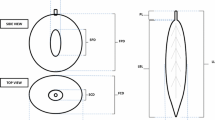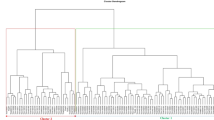Abstract
A cross between the open-pollinated Brassica oleracea cabbage cultivar ‘Wisconsin Golden Acre’ and the hybrid broccoli cultivar ‘Packman’ was used with molecular markers to investigate the genetic control of morphological variation. Twenty-two traits derived from leaf, stem, and flowering measurements were analyzed in 90 F2 individuals that were also classified for genotype by restriction fragment length polymorphism (RFLP) markers. Seventy-two RFLP loci, which covered the mapped genome at an average of 10 map-unit intervals on all nine linkage groups, were tested individually for associations to phenotypic measurements by single factor ANOVA, and markers with significant associations (P<0.05) were used to develop multilocus models. These data were utilized to describe the location, parental contribution of alleles, magnitude of effect, and the gene action of trait loci. Single marker loci that were significantly associated (P<0.05) with trait measurements accounted for 6.7–42.7% of the phenotypic variation. Multilocus models described as much as 60.1% of the phenotypic variation for a given trait. In some cases, different related traits had common marker-locus associations with similar gene action and genotypic class ranking. The numbers, action, and linkages, of genes controlling traits estimated with marker loci in this population corresponded to estimates based on classical genetic methods from other studies using similar, or similarly-wide, crosses. There was no evidence that genome duplication accounted for a significant portion of multiple genes controlling trait loci over the entire genome, but possible duplications of trait loci were identified for two regions with linked, duplicated marker loci.
Similar content being viewed by others
References
Baggett JR, Walhert WK (1975) Annual flowering and growth habit in cabbage-broccoli crosses Hort Science 10:170–172
Detjen LR (1926) A preliminary report on cabbage breeding. Proc Am Soc Hort Sci 23:325–332
Dickson MH (1968) Eight newly described genes in broccoli. Proc Am Soc Hort Sci 93:356
Doebly J, Stec A (1991) Genetic analysis of the morphological differences between maize and teosinte. Genetics 129: 285–295
Edwards MD, Stuber CW, Wendel JF (1987) Molecular-marker-facilitated investigations of quantitative trait loci in maize. I. Numbers, genomic distribution and types of gene action. Genetics 116:113–125
Edwards MD, Heletjaris T, Wright S, Stuber CW (1992) Molecular-marker facilitated investigations of quantitative trait loci in maize. IV. Analyses based on genome saturation with isozyme and restriction fragment length polymorphism loci. Theor Appl Genet 83:765–774
Esau K (1976) Anatomy of plants. John Wiley and Sons, New York
Figdore SS, Kennard WC, Song KM, Slocum MK, Osborn TC (1988) Assessment of the degree of restriction fragment length polymorphism in Brassica. Theor Appl Genet 75:833–840
IBPGR (1987) Descriptors for Brassica and Raphanus. Int Board for Plant Genetic Resources, Rome
Keim P, Diers BW, Olson TC, Shoemaker RC (1990) RFLP mapping in soybean: associations between marker loci and variation in quantitative traits. Genetics 126:735–742
Kristofferson KB (1924) Contributions to the genetics of Brassica oleracea. Hereditas 5:297–364
Kosombi DD (1944) The estimation of map distances from recombination values. Ann Eugen 12:172–175
Nienhuis J, Helentjaris T, Slocum M, Ruggero B, Schaefer A (1987) Restriction fragment length polymorphism analysis of loci associated with insect resistance in tomato. Crop Sci 27:797–803
Osborn TC, Alexander DC, Fobes JF (1987) Identification of restriction fragment length polymorphisms linked to genes controlling soluble solids content in tomato fruit. Theor Appl Genet 73:350–356
Paterson AH, Lander ES, Hewitt JD, Peterson S, Lincoln SE, Tanksley SD (1988) Resolution of quantitative traits into Medelian factors by using a complete linkage map of restriction fragment length polymorphisms. Nature 335:721–726
Pease MA (1926) Genetic situation in Brassica oleracea. J. Genetics 16:363–385
Pelofske PJ, Baggett JR (1979) Inheritance of internode length, plant form, and annual habit in a cross of cabbage and broccoli (Brassica oleracea var. capitata and var. italica plenck). Euphytica 28:189–197
SAS Institute Inc. (1982) User's guide: basic and statistics. SAS Institute, Cary, North Carolina
Slocum MK, Figdore SS, Kennard WC, Suzuki J, Osborn TC (1990) Linkage arrangement of restriction fragment length polymorphism loci in Brassica oleracea. Theor Appl Genet 80:57–64
Snedecor GW, Cochran WG (1980) Statistical methods. Iowa State University Press, Ames, Iowa
Song KM, Osborn TC, Williams PH (1988) Brassica taxonomy based on nuclear restriction fragment length polymorphism (RFLPs). II. Preliminary study on subspecies of B. rapa (syn. campestris) and B. oleracea. Theor Appl Genet 76:593–600
Stuber CW, Edwards MD, Wendel JF (1987) Molecular marker-facilitated investigations of quantitative trait loci in maize. II. Factors influencing yield and its components traits. Crop Sci 27:639–648
Stuber CW, Lincoln SE, Wolff DW, Helentjaris T, Lander ES (1992) Identification of genetic factors contributing to heterosis in a hybrid from two elite maize inbred lines using molecular markers. Genetics 132:823–839
Tanksley SD, Hewitt J (1988) Use of molecular markers in breeding for soluble solids content in tomato-a re-examination. Theor Appl Genet 75:811–823
Tanksley SD, Medina-Filho H, Rick CH (1982) Use of naturally-occurring variation to detect and map genes controlling quantitative traits in an interspecific backcross of tomato. Heredity 49:11–25
Walkof C (1963) A mutant annual cabbage. Euphytica 12:77–80
Weller JI (1987) Mapping and analysis of qunatitative trait loci in Lycopersicon (tomato) with the aid of genetic markers using approximate maximum-likelihood methods. Heredity 59:413–421
Yarnell SH (1956) Cytogenetics of vegetable crops. II. Crucifers. Bot Rev 22:81–166
Young ND, Zamir D, Ganal MW, Tanksley SD (1988) Use of isogenic lines and simultaneous probing to identify DNA markers tightly linked to the Tm-2a gene in tomato. Genetics 120:579–585
Author information
Authors and Affiliations
Additional information
Communicated by J. Beckmann
Rights and permissions
About this article
Cite this article
Kennard, W.C., Slocum, M.K., Figdore, S.S. et al. Genetic analysis of morphological variation in Brassica oleracea using molecular markers. Theoret. Appl. Genetics 87, 721–732 (1994). https://doi.org/10.1007/BF00222898
Received:
Accepted:
Issue Date:
DOI: https://doi.org/10.1007/BF00222898




